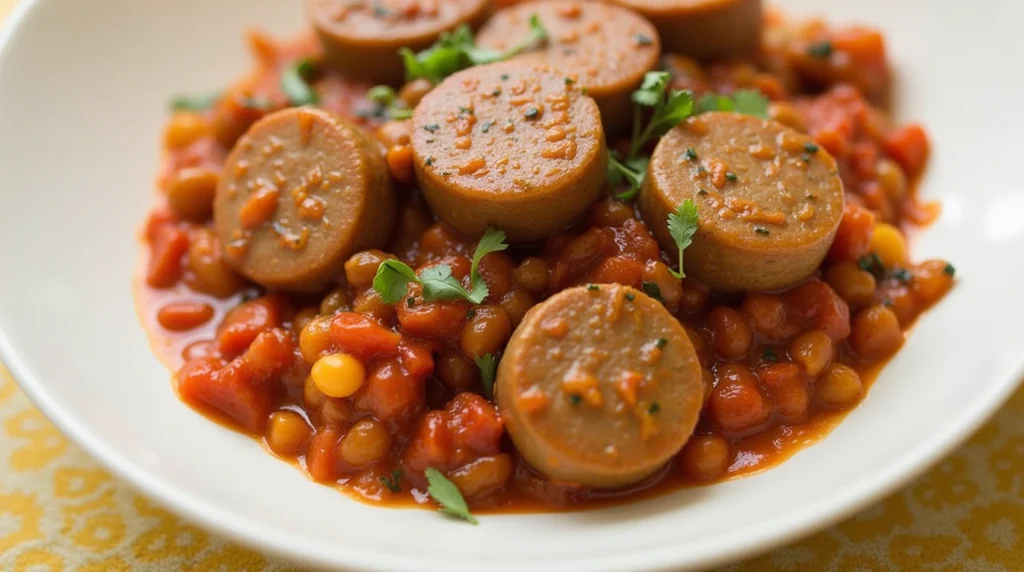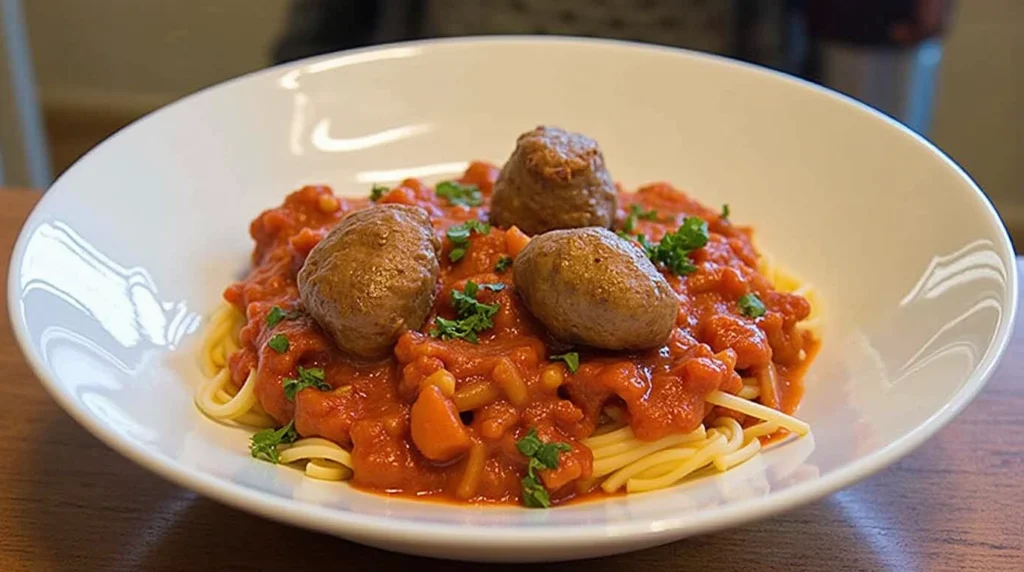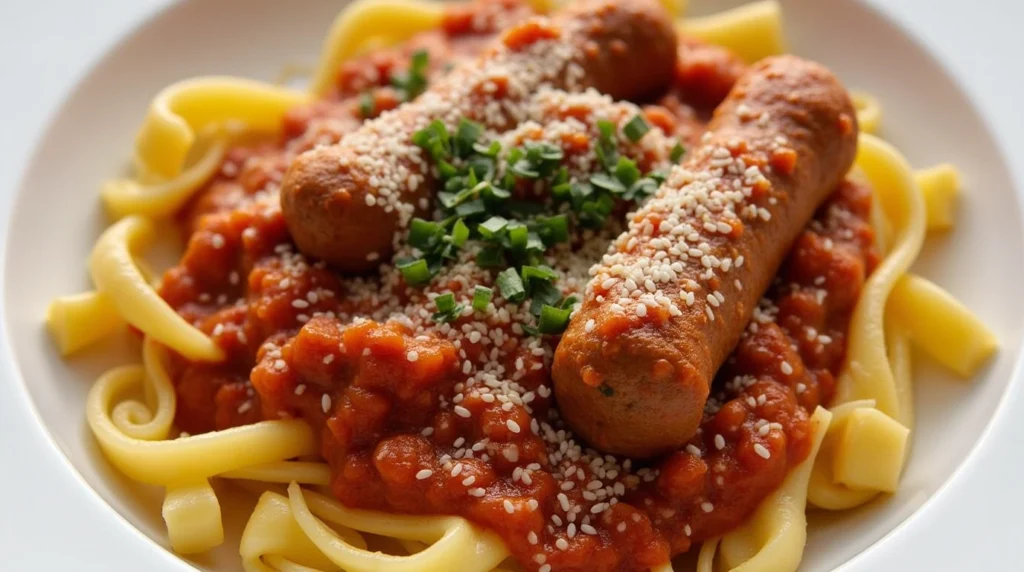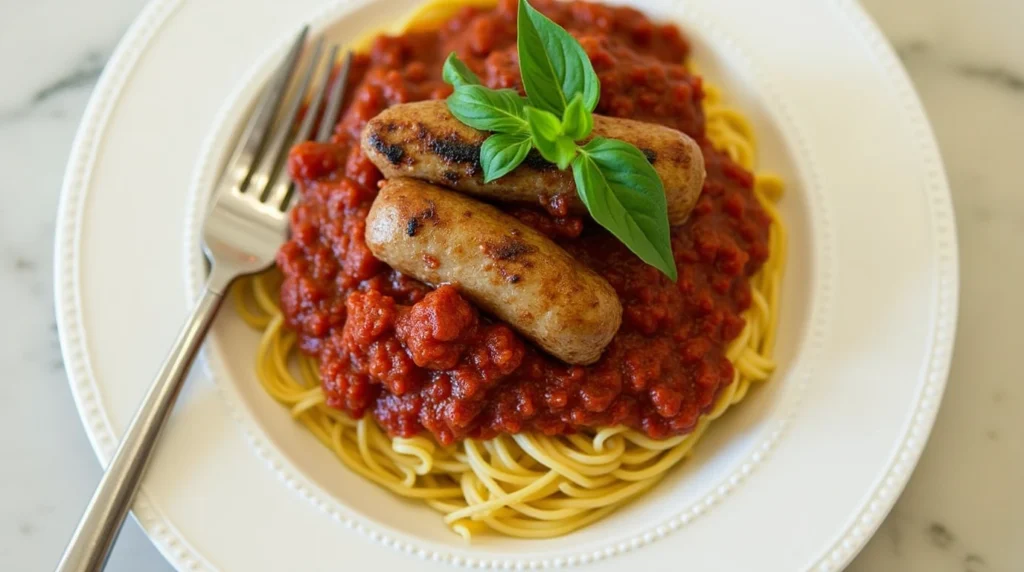Introduction

Ah, the aroma of simmering ragu wafting through the kitchen—there’s nothing quite like Sausage and Pepper Ragu to evoke feelings of warmth and nostalgia. Picture this: a cozy evening at home, with you standing over the stove, stirring a rich, hearty sauce that fills your house with the essence of Italy. This isn’t just cooking; it’s creating memories. Today, we’re diving into one of the most beloved dishes in Italian-American cuisine: Sausage and Peppers Over Polenta . Whether you’re hosting family dinner or simply craving something comforting after a long day, this dish is sure to satisfy.
Let’s explore why this recipe has stood the test of time, how to make it perfectly, and some creative ways to enjoy it. By the end of this guide, you’ll be ready to whip up a batch of this savory delight in no time!
What Is Sausage and Pepper Ragu?
Defining Ragu
Ragu isn’t merely another tomato-based sauce—it’s an experience. Unlike marinara, which relies on fresh tomatoes and herbs for brightness, ragu is all about depth and richness. The key lies in its slow-cooked nature, allowing flavors to meld together beautifully. In our case, the addition of sausages and peppers elevates this classic sauce to new heights. You’ll notice the meaty undertones and sweet pepper notes that create a symphony of taste in every bite.
- Key Characteristics : Meaty, robust, and deeply satisfying.
- Difference from Marinara : While marinara is quick and zesty, ragu requires patience but rewards you with layers of flavor.
Key Ingredients of Sausage and Pepper Ragu
To craft the perfect sausage and pepper ragu, start with these essential ingredients:
| Ingredient | Quantity |
|---|---|
| Italian Sausages (sweet or spicy) | 1 lb |
| Bell Peppers (red, green, yellow) | 2 large |
| San Marzano Tomatoes (crushed) | 28 oz can |
| Olive Oil | 2 tbsp |
| Garlic | 3 cloves |
| Onion | 1 medium |
These ingredients form the backbone of the dish. For added authenticity, consider sourcing high-quality San Marzano tomatoes, known for their sweetness and low acidity.
Why This Dish Is a Comfort Food Classic
There’s a reason sausage and pepper ragu has become such a staple in Italian-American households. Chefs like Giada De Laurentiis and Lidia Bastianich have helped bring this dish into the spotlight, showcasing its versatility and charm. It’s not just food—it’s culture, tradition, and love wrapped into one pot.
- Cultural Significance : Rooted in Southern Italian heritage, this dish brings people together around the table.
- Why It Works : Simple yet sophisticated, it appeals to everyone from picky eaters to gourmet enthusiasts.
Health Benefits of Sausage and Pepper Ragu
Don’t worry—you can indulge guilt-free! Bell peppers are packed with vitamin C and antioxidants, while tomatoes provide lycopene, a powerful nutrient linked to heart health. If you’re watching your calorie intake, opt for leaner sausages or even turkey alternatives.
- Nutritional Highlights : Rich in vitamins and minerals, with options to adjust fat content.
- Tips for Health-Conscious Cooks : Use grass-fed meats or plant-based substitutes if desired.
How to Make Sausage and Pepper Ragu
1 – Prepare Your Ingredients
Before diving into the cooking process, prep everything so you can focus on the fun part. Here’s what you need to do:
- Dice onions finely.
- Mince garlic cloves.
- Cut bell peppers into strips or chunks.
- Remove casings from sausages if using links.
Once prepped, heat olive oil in a large skillet or Dutch oven over medium-high heat. Brown the sausages until golden brown, breaking them apart as they cook.
2 – Build the Sauce
Now comes the magic step where the flavors begin to develop. Add the following to your skillet:
- Sautéed onions and garlic
- Crushed tomatoes
- Fresh basil leaves
- A pinch of red pepper flakes (optional)
Let the sauce simmer gently for at least 30 minutes, stirring occasionally. This slow cooking allows the flavors to deepen and intensify.
3 – Combine Everything Together
After the sauce has simmered, return the cooked sausages and peppers to the pan. Stir well to ensure everything is coated evenly. Taste and adjust seasonings with salt, pepper, or more herbs if needed.
4 – Serve Hot
The final touch? Decide how you want to serve your masterpiece. Options include:
- Over Polenta : Creamy polenta acts as the perfect base for soaking up the flavorful sauce.
- With Pasta : Rigatoni or pappardelle work wonders here.
- On Crusty Bread : Perfect for sopping up leftover sauce.
Tips for Perfecting Your Sausage and Pepper Ragu
Choosing the Right Sausage
Not all sausages are created equal. Look for high-quality Italian sausages made from pork or chicken. Brands like Applegate or local butchers often offer superior products. Don’t shy away from trying both sweet and hot varieties to suit your palate.

Enhancing Flavor with Herbs and Spices
Fresh herbs take this dish to the next level. Consider adding:
- Rosemary for earthiness
- Thyme for subtle floral notes
- Bay leaves for complexity
A dash of red pepper flakes adds a fiery kick without overpowering the other flavors.
Thickening the Sauce
If your ragu seems too thin, try one of these methods:
- Reduce liquid by letting it simmer uncovered for longer.
- Stir in a spoonful of tomato paste for extra thickness.
- Avoid over-thickening, as the sauce should retain a smooth, velvety texture.
Storing Leftovers
Proper storage ensures you can enjoy this dish for days. Store leftovers in an airtight container in the fridge for up to five days or freeze portions for up to three months. Reheat gently on the stovetop or microwave, adding a splash of water if necessary.
Creative Ways to Enjoy Sausage and Pepper Ragu
Pairing with Polenta
Polenta is a natural companion for ragu. To prepare creamy polenta:
- Bring water or broth to a boil.
- Gradually whisk in polenta cornmeal.
- Simmer until thickened, stirring frequently.
Top with your ragu and sprinkle grated Pecorino Romano cheese for richness.
Serving Over Pasta
Choose sturdy pasta shapes like rigatoni or pappardelle to hold up against the hearty sauce. Toss cooked pasta with the ragu and finish with freshly grated Parmesan.
Turning It Into a Sandwich
Leftover ragu makes an excellent sandwich filling. Spread it generously onto ciabatta or baguette slices, top with melted mozzarella, and grill until golden.
Vegetarian Alternatives
For a plant-based version, replace sausages with mushrooms or lentils. These ingredients mimic the texture and umami flavors of meat, keeping the dish just as delicious.
Exploring Regional Variations of Sausage and Pepper Ragu
Every region in Italy—and beyond—has its own take on this classic dish. Let’s delve into a few variations that might inspire your next culinary adventure.
Neapolitan-Style Ragu
Neapolitan ragu often includes pancetta or guanciale for added richness. This version typically uses smaller cuts of meat, such as pork shoulder or beef brisket, slow-cooked with tomatoes, onions, and herbs. To replicate this style at home:
- Add diced pancetta to the initial sauté.
- Use a mix of ground meats (beef, pork, and veal) instead of just sausage.
- Incorporate red wine during cooking for depth.
Tuscan-Inspired Ragu
Tuscany is known for its rustic simplicity. Their version of ragu focuses on letting the natural flavors of the ingredients shine. For a Tuscan twist:
- Skip the bell peppers and focus on garlic, rosemary, and thyme.
- Use fewer spices but emphasize quality ingredients like extra virgin olive oil and fresh tomatoes.
- Serve over ribbons of pappardelle or alongside roasted potatoes.
Americanized Fusion Versions
In the U.S., chefs have experimented with fusion elements to make sausage and pepper ragu even more exciting. Try these ideas:
- Asian Fusion : Add soy sauce, ginger, and sesame oil to give the dish an umami boost.
- Mediterranean Twist : Include sun-dried tomatoes, Kalamata olives, and feta cheese for a salty tang.
- Spicy Kick : Increase the heat with harissa paste or chili flakes for those who love bold flavors.

Perfect Wine Pairings for Sausage and Pepper Ragu
Choosing the right wine can elevate your dining experience. Here are some pairing suggestions based on the flavor profile of your ragu:
Non-Alcoholic Options
For non-drinkers, consider serving:
- Sparkling water with lemon slices.
- Herbal teas like chamomile or peppermint for a soothing finish.
Tips for Hosting a Sausage and Pepper Ragu Dinner Party
If you’re planning to serve this dish at a gathering, here are some tips to ensure success:
Plan Ahead
- Prepare the ragu ahead of time and reheat it gently before serving.
- Cook polenta or pasta just before guests arrive to keep it fresh.
Set the Mood
- Dim lighting and soft music create an inviting atmosphere.
- Arrange the table with rustic Italian decor, such as burlap napkins and terracotta plates.
Offer Variety
- Provide options for dietary restrictions, such as gluten-free pasta or a vegetarian ragu.
- Include side dishes like caprese salad or bruschetta to round out the meal.
Troubleshooting Common Issues
Even experienced cooks encounter challenges from time to time. Here’s how to handle them:
Sauce Too Watery?
- Simmer uncovered to reduce excess liquid.
- Stir in tomato paste or cornstarch slurry for quick thickening.
Not Enough Flavor?
- Taste frequently and adjust seasonings as needed.
- Consider adding a splash of vinegar or citrus juice for brightness.
Sausages Overcooking?
- Cook sausages separately until browned, then remove them from the pan while building the sauce.
- Return them later to prevent overcooking.
Leftover Ideas for Sausage and Pepper Ragu
Don’t let leftovers go to waste! There are countless ways to repurpose this versatile dish.
Breakfast Idea – Ragu Frittata
Combine leftover ragu with eggs, spinach, and Parmesan cheese for a savory breakfast frittata.
Pizza Topping Extravaganza
Spread ragu over pizza dough, top with mozzarella and arugula, and bake until golden.
Stuffed Vegetables
Use ragu as a filling for bell peppers, zucchini boats, or mushrooms for a delicious appetizer or main course.
Mastering the Art of Slow Cooking for Ragu
Slow cooking is the secret weapon behind a truly exceptional ragu. The longer the ingredients simmer together, the more their flavors meld into a harmonious symphony. Here’s how to master this technique:
Why Slow Cooking Works
- Flavor Development : Prolonged heat allows natural sugars in tomatoes and peppers to caramelize, enhancing sweetness.
- Tender Meats : Sausages break down slowly, releasing juices that enrich the sauce.
- Texture Balance : Vegetables soften while retaining their integrity, contributing to the overall consistency.
Equipment Options
- Stovetop Method : Ideal for hands-on cooks who prefer control over the process.
- Slow Cooker : Perfect for busy schedules; simply layer ingredients and let it do the work.
- Instant Pot : Combines pressure cooking with slow-cooking benefits, cutting down on time without sacrificing flavor.
Tips for Success
- Start with cold ingredients to prevent scorching at the bottom of the pot.
- Deglaze the pan with wine or stock after browning sausages to capture fond (brown bits) for added depth.
- Stir occasionally to ensure even heating and prevent sticking.
Understanding Key Ingredients in Depth
To elevate your dish, understanding each ingredient’s role is crucial. Let’s dive deeper into what makes Sausage and Pepper Ragu so irresistible.
Italian Sausages – A Closer Look
Italian sausages come in various forms, each offering distinct characteristics:
- Sweet Sausage : Mildly spiced with fennel seeds, perfect for a family-friendly meal.
- Hot Sausage : Spicy due to red pepper flakes, ideal for those who enjoy bold flavors.
- Turkey or Chicken Sausage : Leaner options for health-conscious cooks, though they may lack the richness of pork.
For best results, choose fresh sausages rather than pre-cooked ones. If using links, remove the casings before crumbling them into the pan.
Bell Peppers – More Than Just Color
Bell peppers aren’t just decorative—they play a vital role in balancing the dish:
- Red Peppers : Sweet and slightly fruity, adding natural sugar to the sauce.
- Green Peppers : Earthy and less sweet, providing contrast.
- Yellow Peppers : Juicy and mildly sweet, blending seamlessly with other ingredients.
Roasting peppers beforehand enhances their flavor profile by concentrating their sugars and imparting a smoky aroma.
Tomatoes – The Foundation of Ragu
San Marzano tomatoes are often hailed as the gold standard for Italian sauces. Their low acidity and meaty texture make them ideal for ragu. However, if unavailable, substitute with high-quality canned whole peeled tomatoes, crushed by hand for better texture.

Elevating Your Presentation
Presentation matters, especially when serving guests. Here’s how to make your Sausage and Pepper Ragu visually appealing:
Garnishes That Pop
- Fresh basil leaves sprinkled generously over the dish.
- Grated Parmesan or Pecorino Romano cheese for an elegant finish.
- A drizzle of extra virgin olive oil for shine and richness.
Plating Ideas
- For polenta, create a bed of creamy polenta topped with a generous ladle of ragu.
- With pasta, toss rigatoni or pappardelle in the sauce and garnish with parsley and grated cheese.
- For sandwiches, layer ragu between slices of crusty bread and top with melted mozzarella for a gooey effect.
Educational Insights – The Science Behind Great Sauce
Understanding the science behind cooking can help you troubleshoot and improve your techniques. Here’s a glimpse into what happens during the preparation of ragu:
Maillard Reaction
When browning sausages, the Maillard reaction occurs—this is the chemical process where amino acids and sugars react under heat, creating complex flavors and aromas. This step is critical for building the foundation of your sauce.
Emulsification
Adding fats like olive oil and proteins from sausages creates an emulsion, resulting in a smoother, creamier texture. Stirring frequently helps stabilize this mixture.
Acidic Balance
Tomatoes naturally contain citric and malic acids, which brighten the sauce. Balancing acidity with sugar from roasted peppers ensures a well-rounded taste.
Incorporating Seasonal Ingredients
Adapting your recipe to seasonal produce not only supports local farmers but also enhances flavor. Consider these ideas:
Spring Version
- Use fresh spring onions instead of regular onions.
- Add peas or asparagus for a vibrant pop of color and freshness.
Summer Version
- Swap bell peppers with zucchini or eggplant for a lighter twist.
- Incorporate fresh heirloom tomatoes for peak sweetness.
Fall/Winter Version
- Roast root vegetables like carrots and parsnips alongside peppers for added depth.
- Dust with cinnamon or nutmeg for warmth during colder months.
FAQs About Sausage and Pepper Ragu
Can I Use Pre-Made Tomato Sauce?
Yes, though homemade sauce offers better control over ingredients and flavor. If opting for store-bought, choose brands like Rao’s or Muir Glen for quality assurance.
How Long Should Ragu Simmer?
Aim for at least 30 minutes to develop flavors fully. Longer simmer times (up to two hours) yield even richer results.
Can I Make This in a Slow Cooker?
Absolutely! Simply layer ingredients in the slow cooker and let it cook on low for six to eight hours. Adjust seasoning before serving.
Is Sausage and Pepper Ragu Gluten-Free?
It depends on the ingredients used. Ensure sausages and any thickeners are gluten-free. Swap out pasta for gluten-free alternatives if needed.
Conclusion
Sausage and Peppers Over Polenta is more than just a meal—it’s an invitation to connect with loved ones and celebrate life’s simple pleasures. With this comprehensive guide, you now possess the tools to create a mouthwatering dish that will leave everyone asking for seconds. So roll up your sleeves, gather your ingredients, and get cooking!
